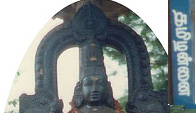
 |
||
| Home Culture Lessons > I 1 2 3 4 5 6 II 1 2 3 4 5 6 III 1 2 3 4 5 6 IV 1 2 3 4 5 6 V 1 2 3 4 5 6 VI 1 2 3 4 5 6 Select Unit | ||
|
| ||
Nick namesMany proper names in Tamil have a shorter version which is used as an address term. People of equal status can address each other with shortened names, and superiors or elders can address persons younger than them with shortened names, but not the other way around. Young people addressing their elders with nick names is considered impolite. Calling someone using short names implies intimacy or affection. In some cases, the original name may not even be that long in the first place, but it would be shortened to show intimacy and affection. There are no specific rules for how to shorten long names, and one has to learn from the usage. Following are some of the commonly used long and their short names.
சுப்பிரமணியன் --> சுப்புனி or மணி or சுப்பு பாலசுப்பிரமணியன் --> பாலு கண்ணபிரான் --> கண்ணன் or கண்ணா ராஜாராமன் --> ராமன் or ராமா or ராமு ராமமூர்த்தி --> மூர்த்தி or ராமு முருகன் --> முருகு விக்னேஷ் --> விக்கி ரங்கனாதன் --> ரங்கா or ரங்கன் ஹரிஹரன் --> ஹரி பட்டாபிராமன் --> பட்டாபி லலிதா --> லல்லி சுபாஷினி --> சுபா ரவிஷங்கர் --> ரவி விஜயலக்ஷ்மி --> விஜி or லக்ஷ்மி or விஜயா Use of Place names along with proper namesPlace of birth, residence, origin etc., are some times used along with proper names as addressing terms. Many celebreties are popularly known by their place of origin.
பட்டமங்களம் சுப்புலக்ஷ்மி வலையப்பட்டி வைத்தியனாதன் சேந்தங்குடி சீனிவாசன் Use of caste names as titleIt is common among elders to address each other with their caste names as title, usually among upper castes like ஐயர், பிள்ளை, முதலியார், செட்டியார், நாடார் and so on. While in some contexts calling someone with their caste name is considered very polite, in other contexts--namely formal institutions such as schools, government offices, etc. that aim to abolish caste distinctions--it is considered indecent. Following are some of the typical names with caste names attached. ராஜாராமன் ஐயர் 'Rajaraman Iyer' சுந்தரம் ஐயங்கார் 'Sundaram Iyengar' மீனாக்ஷி சுந்தரம் பிள்ளை 'Meenakshi Sundaram Pillai' ஆறுமுக முதலியார் 'Arumuga muthaliyar' வேங்கைய நாய்டு 'Vengkaiya Naydu' Some times, names of towns or villages are also attached to these names. பட்டுக்கோட்டை ராமலிங்கப் படையாச்சி 'Pattukotai Ramalingka Padaiyachi' மதுரை கிருஷ்ணசாமித் தேவர் 'Mayiladuthurai Kirushnasami Thevar' Professon names such as ஆசாரி 'carpenter', குருக்கள் 'priest', பத்தர் 'gold smith' etc., names referring to sainthood such as சுவாமிகள், அடிகளார் etc., are also possible candidates to be used with proper names. It is also very common for devotees to call their priest சாமி, servants to call their their master ஐயா, wives to call their their husband அத்தான், மச்சான், parents to call their children affectionately கண்ணு, செல்லம் etc., without using their names. Last NameThere is no concept of either 'family name' or 'last name' as such in Tamil culture. The caste names refer to particular caste community, but not a family lineage. This causes trouble when the Tamils visit the foreign countries where everyone is identified by first name and last name. Often, in such circumstances Tamil immigrants use their father's name as their last name. In official records in India, everyone is identified by the first initial of their father or husband along with a first name. So, the official records would list names like: K. கோவிந்தசாமி or கே. கோவிந்தசாமி where கே stands for Govindasami's father's name, for example கோபால், கிருஷ்ணன் or any other name that begins with க். Sometimes some people might be called by the abbreviation of their names as எச். ஏ for S. Agoram, கே. ஏ. கே. for K. A. Krishnasamy with the the letter 'K' can stand for the name of the town he belongs to and 'A' refering to his father. Addressing by initials is common for a number of famous Tamil actors and politicians. For example, எம். ஜி. ஆர். (MGR) for மருதூர் கோபாலமேனன் ராமச்சந்திரன் (M. G. Ramachandran), one of the most popular Tamil actors and Chief Minister of Tamil Nadu from 1977-1987; ஈ. வே. ஆர். (EVR) for ஈரோடு வேங்கடசாமி ராமசாமி நாயக்கர்(E. V. Ramaswamy), an iconoclast leader of the Tamil non-Brahmin movement and founder of the திரவிட கழகம் (DK) political party; and (CNA) for சின்னகாஞ்சீபுரம் நடராஜன் அண்ணாதுரை, the founder of the திராவிட முன்னெற்றக் கழகம் (DMK) political party. Attributes of reverence:The equivalent to 'Mr.' in Tamil is திரு (m), and 'Mrs.' is திருமதி. Unlike in English, the attribute திரு is used only with names of adult male persons, and திருமதி for married women. The word அவர்கள் 'respected' is usually added after proper names. Following are some of the examples of addressing Tamils reverentially.திரு ராமராஜன் அவர்கள் Mr. Ramarajan (honorable) The word திருவாளர் is the equivalent of திரு but is used to refer to young persons - usually teenagers. There are also other attributes of reverence such as மதிப்பிற்குரிய 'respected', செம்மனச்செம்மல் 'generous' and so on. Religiously significant attributes such as அருள்மிகு 'gracious', சுவாமிகள் 'divinely' etc., are also widely used along with propers names. Using too many attributes of this kind for a single is not uncommon in Tamil. பெரு மதிப்பிற்குரிய பெருங்கொடை வள்ளல் புகழ் மிகு பெருந்தகை திரு கோபிநாதன் அவர்கள் 'Highly respected, very generous, famous, Mr. Kopinaathan'. ஏழைப் பங்காளி கருணை மிகு திருமதி கன்னியாகுமரி கண்ணம்மா அவர்கள் முன்னிலையில் இந்தத் திருவிழா நடைபெறும். 'This function will be conducted in the presence of Mrs. Kanniyakumari (place name) Kannammaal (proper name) who is for the welfare of the poor and a very gracious person. |
|
© South Asia Language Resource Center (SALRC) |